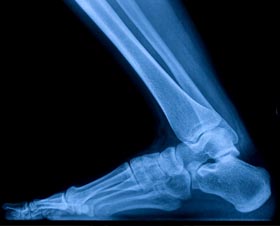The Dreaded Stress Fracture
Posted May 31st, 2009

Every runner fears a stress fracture. Understanding how this diabolical, disabling injury occurs can help prevent it. The words “stress fracture” are really a misnomer, as the injured bone does not present radiological evidence of a true fracture line. The bone is not really broken or fractured, as in a crushing or severe twisting injury. “Chronic repetitive stress injury of bone” is a more appropriate and accurate term. The sports medicine clinician usually refers to the acronym, RSI or the nickname stress reaction injury.
RSI DEFINED
First described in 1855 by a Prussian military physician when he recognized the problem in new recruits forced to march long distances, with heavy backpacks, in training maneuvers. He coined “march fracture,” a name that has persisted for a very long time, until the running boom, when increasing injuries of this nature began to occur. This led to research, and findings proved the injury is most common with repetitive motion activities such as marching, walking, jumping, or running.
Julius Wolff, a 19th-century research anatomist and surgeon described the reaction of bone to repetitive stress. Simply put, Wolff’s Law describes bone remodeling that is secondary to stress. Bone will gradually become stronger, resisting small increasing doses of stress, by a process of bone resorbtion and subsequent repair. The bone will become thicker, more dense, and stronger. Applying Wolff’s Law, the lower extremity of the runner means a gradual adaptation to ground reactive forces (GRF), which may be as high as the multiple of 10 or 12 in the inefficient athlete, or when workout regimens change.
As an example, the 145-pound male runner may actually be producing forces on the bones of his feet and legs that would be equal to weighing 1,450 to 1,740 pounds. According to Wolff the bones would accept this increased GRF and associated stress when they are given time to adapt. Bone is dynamic, and it is subject to change with stimulus. Given adequate time to recover and repair, bones will become stronger and will be able to handle greater loads over longer distances. Without recovery and rest, the bone will suffer an accumulation of micro-damaged areas, with loss of ability to resorb/repair/remodel. Loss of these cycles result in injury and pain. RSI, or the dreaded stress fracture, is the result, and it is usually caused in runners with training errors.
MOST COMMONLY AFFECTED BONES
The tibia (largest of the two lower leg bones) is the most common site of RSI. Symptoms usually begin with what is commonly referred to as “shin splints,” or pain on the front of the shins. RSI can also occur in the smaller fibula, as well as the femur in the thigh, and also in the pelvis.
Every bone of the foot is susceptible to RSI. The metatarsals are the most common sites of injury, with the second metatarsal having the highest percentage rate. RSI usually affects the neck or shaft of the metatarsals, and when the injury is at the base it may be an indication of too much hill training or speed work. The vector of stress will be placed in the base of the metatarsal when running on the ball of the foot. Injury of the cuneiform bones are also subject to the higher impact of running on the ball of the foot. RSI of the calcaneous can follow untreated chronic plantar fascitis.
THE TERRIBLE TOOS
Avoid too much, too soon, too often, too fast, and your chances of getting injured will be greatly reduced. These “toos” will overstress bones before they have a chance to appropriately react by developing reinforced bone growth and increased density.
Other training errors are using worn shoes or shoes that fail to meet the biomechanical requirement of your feet or body type. At my clinic, we often see increased incidence of RSI in the feet and legs of athletes who hyperpronate. SRI is seen more in women than in men. Studies have shown that increased hyperpronation, secondary to the higher Q-angle in women, plays a role. Injury because of this can be avoided or minimized with the use of orthotics and proper running shoes. Other studies point to metabolic disorders or deficient nutrition that may lead to bone demineralization.
DIAGNOSIS AND TREATMENT
The symptom of RSI is always pain that is exacerbated and intensified with a continuation of activity. The pain will subside rather rapidly once exercise stops. Suspicion of a stress fracture, or RSI, begins with the athlete recognizing the earliest symptom: localized increased and unrelenting pain with exercise, and its relief with cessation of motion.
I like to paint a word image for patients who I suspect of presenting with a stress fracture. “How do you feel at the beginning of your run? How do you feel after running for 30 minutes? What happens when you stop?” If the answers are “Fine,” “It hurts,” and “The pain stops,” I would suspect RSI. Finally I ask, “What if you continued to run? Would the pain increase? When the answer is “Yes” I strongly suspect RSI.
If your injury fits this profile you should make an appointment with a sports medicine provider. X-rays are usually negative but a starting point. Diagnosis made with MRI is best and most accurate. Bone scans often offer inadequate or false information.
Conservative treatment is usually adequate. This may consist of using a Cam-Walker, crutches, or both. There is increasing evidence that Platelet Rich Plasma injection therapy in the injured bone site using ultrasound guidance enhances and hastens recovery. The best medicine, however, is prevention, and the answer is usually in your training log.
